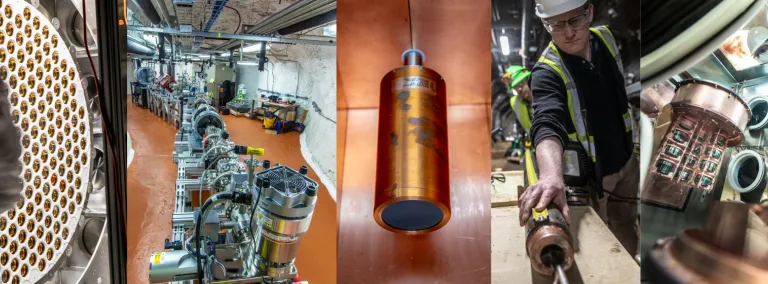Science impact
SURF advances world-leading science and inspires learning across generations
The Sanford Underground Research Facility (SURF) advances world-leading science and inspires learning across generations.
We support active research in particle and nuclear physics and other science disciplines. While still a gold mine, the facility hosted Ray Davis's solar neutrino experiment, which shared the 2002 Nobel Prize in Physics. His work is a model for other experiments looking to understand the nature of the universe.
The facility's depth, rock stability and history make it ideal for sensitive experiments that need to escape cosmic rays. The impacts on science can be seen worldwide.
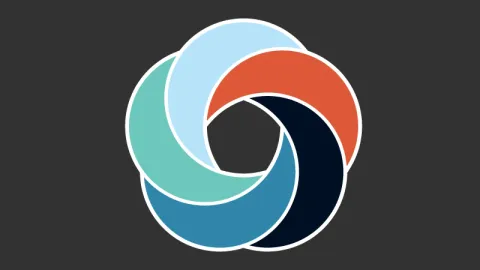
Our science as national priority
In 2023, the Department of Energy's High Energy Physics Advisory Panel (HEPAP) committee prioritized physics experiments, giving neutrino and dark matter projects high-priority.
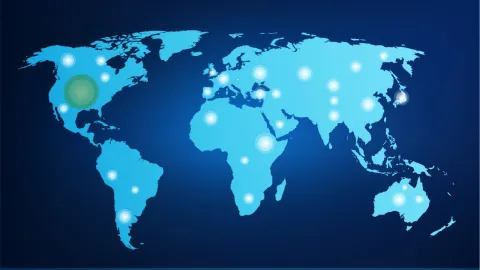
International investment and cooperation
The Sanford Underground Research Facility hosts a variety of research projects in many disciplines. Researchers from around the globe use the facility to learn more about our universe, life underground, geothermal energy, and the unique geology of the region.
The site also allows scientists to share and foster growth within the science community and encourages cooperation among many countries and institutions.
Several hundred researchers from dozens of institutions around the world currently perform research deep underground on such experiments as the LUX-ZEPLIN, Majorana Demonstrator, CASPAR, and other experiments. Additionally, SURF is a test bed for Caterpillar's MineStar technology.
Now under construction, the Long-Baseline Neutrino Facility and Deep Underground Neutrino Experiment will increase those numbers significantly. Managed by the Department of Energy's Fermilab, the LBNF/DUNE collaboration boasts more than 1400 researchers from over 200 institutions and 37 countries. And for the first time in its history, CERN is investing in an experiment outside of the European Union.
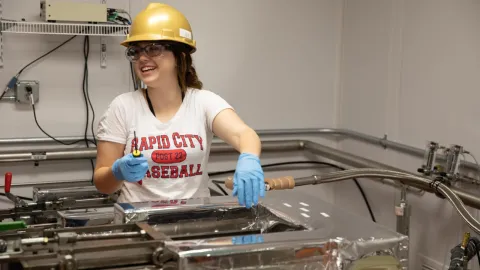
Local impact
Building laboratory spaces deep underground at Sanford Lab created new opportunities for higher education in South Dakota. In 2012, the Board of Regents authorized a joint Ph.D. physics program at the South Dakota School of Mines and Technology in Rapid City and the University of South Dakota in Vermillion. Since then, dozens of students have participated in the program and worked on experiments at Sanford Lab. In 2017, each university saw their first students complete the program.
To date, there are 31 research projects housed at Sanford Lab, several of which include students and faculty from universities across South Dakota.
The Black Hills State University Underground Campus (BHUC), for example, provides a space for students from across the state to perform interdisciplinary research underground. While physics students contribute to large-scale experiments as by working in the low background counting facility, students from other disciplines work with researchers in biology, geothermal energy, and engineering.

Global footprint
Competition for underground laboratory space is fierce. With the completion of the Long-Baseline Neutrino Facility (LBNF) construction, SURF will host approximately 25 percent of the total volume of underground laboratory space in the world. However, all laboratory space underground at SURF is fully subscribed. Recently, two major USA-funded experiments chose underground labs in Canada and Italy because they have space available now. Sanford Underground Research Facility must expand to remain competitive worldwide and to continue drawing world-leading research to South Dakota.

Deep competition
SURF is the deepest underground lab in the U.S. at 1,490 meters. The average rock overburden is approximately 4300 meters water equivalent for existing laboratories on the 4850 Level. The underground laboratory space has a strong track record of meeting experiment needs. Other labs around the world are deeper than SURF including one that came online in 2024.
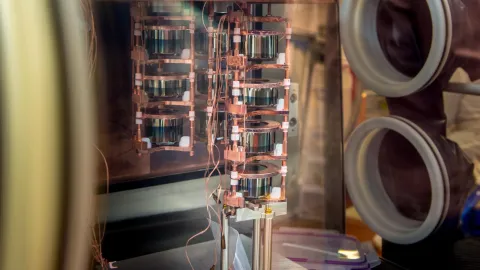
Neutrino science impacts
Beginning with Dr. Ray Davis’ groundbreaking neutrino research (1965-1992), SURF have dedicated to refining knowledge about neutrinos and other research.
The Majorana Demonstrator Project collected physics data for six years. Final physics results were published in February 2022, proving that the techniques used by the collaboration could be deployed on a much larger scale to search for the rare, never-before-seen decay that could help explain the existence of matter in our Universe.
The MJD project invested significant resources to produce the world’s purest copper. In parallel with ongoing MJD operations, specific elements—such as electronics upgrades and copper electroforming—are being pursued at SURF in the context of R&D for the next-generation neutrinoless double-beta decay experiment, Large Enriched Germanium Experiment for Neutrinoless bb Decay (LEGEND). Extraordinary levels of material radiopurity will be required to reach the LEGEND-1000 background goal.
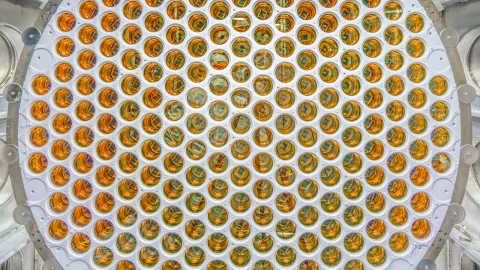
Dark matter science impacts
The LUX-ZEPLIN (LZ) experiment is the upgraded successor to the highly successful Large Underground Xenon (LUX) experiment. LUX held world-leading sensitivity for approximately three and a half years over most of the WIMP-mass region. The LZ experiment was one of two direct-search, next-generation dark matter experiments selected for funding by DOE’s Office of High Energy Physics (HEP).
LZ involves a collaboration of 250 scientists, engineers and technicians from 38 institutions, including five U.S. National Labs. LZ's sensitivity level is 100 times better than the final LUX search result in 2016 for weakly interacting massive particles (WIMPs), the leading dark matter particle candidate.
The experiment began operating in July 2022, using 10 tonnes of liquid xenon within an ultra-pure titanium cryostat surrounded by a new liquid scintillator veto system. The entire experiment was immersed in a 72,000-gallon tank filled with ultra-pure water. After a 60-day run in 2023, LZ was named the most sensitive dark matter experiment in the world.
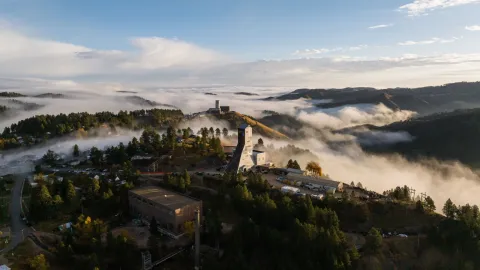
SURF has a surface footprint is 223 acres
The local footprint of the facility includes 223 acres on the surface. Facilities at both the Yates and Ross surface campuses offer researchers administrative support, office space, communications and education and public outreach. The Waste Water Treatment Plant handles and processes waste materials, while the warehouse handles shipping and receiving for the facility as a whole.
SURF has an underground footprint of 370 miles
Of the 370 total miles of underground space, Sanford Lab maintains approximately 12 for science at various levels, including the 300, 800, 1700, 2000, 4100 and 4850 levels. The Davis Campus on the 4850 Level is a world-class laboratory space that houses experiments for neutrinoless double-beta decay and dark matter.
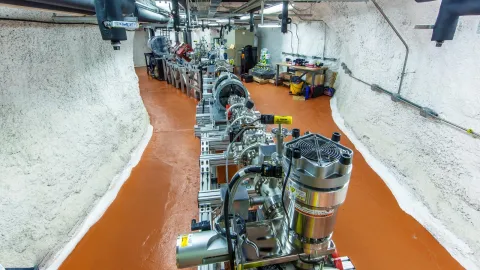
Astrophysics impacts
The CASPAR experiment, led by SD Mines, studies stellar nuclear fusion reactions, especially neutron production for slow neutron-capture nucleosynthesis (s-process). Accelerator components were relocated from the University of Notre Dame in 2015, and since the first beam in May 2017 and the first operations event in July 2017, accelerator commissioning has continued. Advanced commissioning data were obtained starting in February 2018 using the domain of interest for stellar CNO reactions.
“Researchers at CASPAR are engaging a community of researchers. Although Notre Dame and SD Mines are at the core, the collaboration continues to reach out to other research groups to build interest. One of the biggest impacts in South Dakota is the number of grad students participating in the Physics Ph.D. program in the state.” —Jaret Heise
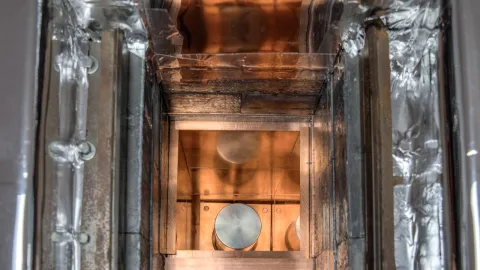
Low-background counting impacts
The BHUC houses a low-background counting facility where components for physics experiments, including current and future Sanford Lab experiments, can be assayed. There has been significant interest in the BHUC low-background counting facility from many groups, including the Sub Electron Noise Skipper-CCD Experimental Instrument (SENSEI) experiment, which aims to search for low-mass dark matter using ~100 g of silicon CCD sensors, and the Germanium Internal Charge Amplification for Dark Matter Searches (GeICA) project.
Six high-purity germanium detectors are currently operating at the facility, with installation of an additional germanium detector expected in 2019. These low-background counters have been instrumental in characterizing materials for the LZ experiment for the past several years.
“The campus at Sanford Lab is an ideal location for these counters. Not only does its depth create a shield for the detectors, but it’s in the thick of major physics experiments—it’s where the action is.” —Kevin Lesko, senior scientist at Lawrence Berkley National Lab (Berkeley Lab) who manages the measurement and control of backgrounds

Geology research impacts
Funded by the Department of Energy’s Geothermal Technologies Office, the EGS Collab seeks to “enhance” permeability in rock formations by opening existing fractures or creating new fractures. But first, they want to answer some questions: How quickly should fractures be opened? Is it better to prop fractures open or to shear the rock? And how long will geothermal reservoirs last before the hot rock begins to cool?
The EGS Collab has been investigating these questions at SURF since 2017, first on the 4850 Level and now on the 4100 Level. Using these "testbeds," researchers drilled boreholes deep into the rockface and outfitted the boreholes with a dense array of sensors and instrumentation to stimulate and monitor the rock. The research will support the DOE flagship EGS effort called the Frontier Observatory for Research in Geothermal Energy (FORGE).
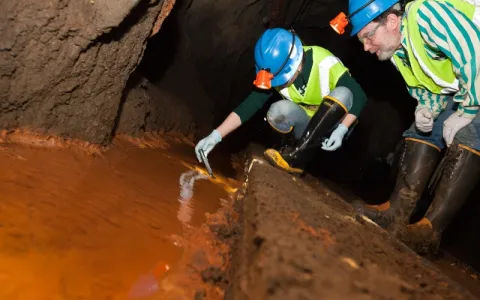
Biology opportunities
Important questions in life science, such as the conditions of life, the extent of life and ultimately the rules of life, are also being addressed underground at SURF. Generally, these programs have a small footprint in existing spaces and require only modest support from the facility. Biology researchers take full advantage of SURF’s footprint by gathering samples from a number of underground levels and areas with different temperatures and geologic mineralogies. Various groups focus on the diversity of life, including rock-hosted microbial ecosystems, and engineering applications such as improvements to biofuel production.

Engineering
The Sanford Underground Research Facility offers a variety of environments in which engineers can test real-world applications and new technologies. And the rich history of the Homestake Mine, which includes a vast archive of core samples, allows engineers to better understand how to excavate caverns for new experiments.
